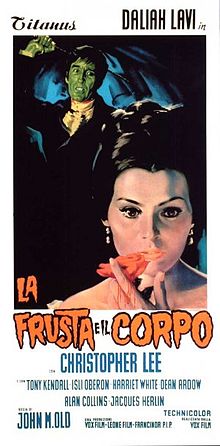 One of the strangest and most interesting films made by Mario Bava, a film featuring ahead-of-its-time perversity and the type of visual brilliance for which Bava is renowned.
One of the strangest and most interesting films made by Mario Bava, a film featuring ahead-of-its-time perversity and the type of visual brilliance for which Bava is renowned.
For years this 1963 film, with its none-too-disguised sadomasochistic underpinnings, was known in edited form in the U.S. as WHAT, with direction credited to “John M. Old.” Only in 2000 did THE WHIP AND THE BODY (LA FRUSTA E IL CORPO) become commercially available in its original uncut version, in a now out-of-print DVD from VCI Home Video.
The obnoxious Kurt has returned to the mansion where his former lover Nevenka resides with her family and husband, who happens to be Kurt’s brother. It seems the latter was forced into marrying Nevenka by her father in an effort at weaning her away from Kurt. Yet Kurt retains his hold over Nevenka, which, as evinced by a beachside encounter in which he whips her and she enjoys the abuse, is quite twisted.
The following night Kurt is killed, much to the relief of Nevenka’s father and husband. His ghost, however, is glimpsed by Nevenka through windows, and the sound of his cracking whip is heard. Nevenka sees Kurt’s mud-spattered boots creep through her room one night, and his hand emerge from out of the shadows to rip off her blouse and whip her, just as he did that fateful day on the beach. Kurt’s ghost vows to enact revenge on Nevenka’s family, and, sure enough, the next morning Nevenka’s father is found dead.
Further appearances by Kurt assail the mansion’s other inhabitants until they decide to open Kurt’s tomb. At this point Kurt reappears to Nevenka, reminding her that she loves him dearly—which she tries to deny—and exhorting her to join him in the afterlife.
Nobody has ever managed to replicate the sumptuous, multi-hued visuals of Mario Bava, which are among the most distinctive and virtuosic of any filmmaker. For proof check out THE WHIP AND THE BODY, which is among Bava’s most visually expressive films.
The film’s early nighttime scenes, with their delirious color scheme and painterly juxtaposition of light and darkness, are a veritable gothic wet dream highlighted by one of Bava’s most striking images: a green-lit hand emerging from out of the darkness (which the heroine accurately likens to “a green spider”). A wildly excessive faux-romantic score completes the impression.
In the film’s second half the atmosphere shifts somewhat, from a freaky romance to a more conventional, but no less eye-popping, ghost story. Nevenka is here relegated to a supporting role—a mistake, seeing as how the whip-loving Nevenka, as incarnated by the Israeli knockout Daliah Lavi, is far and away the most interesting of the film’s characters outside the sadistic Kurt.
The latter is played by Christopher Lee. Kurt is one of the great man’s most striking roles, with Lee’s imposing physical presence and haunted aura put to excellent use by Bava (although Lee’s amazing voice has, as per the custom with Italian movies of the time, been dubbed over by a far less distinctive one). It’s great we now have the chance to see this film in its definitive form, and so can fully appreciate the artistry of Bava and Lee, both of whom were at their most inspired herein.
Vital Statistics
THE WHIP AND THE BODY (LA FRUSTA E IL CORPO)
Francinor PIP/Leone Film
Director: Mario Bava
Producers: Elio Scardamaglia
Screenplay: Ernesto Gastaldi, Ugo Guerra, Luciano Martino
Cinematography: Ubaldo Terzano
Editing: Renato Cinquini
Cast: Christopher Lee, Daliah Lavi, Tony Kendall, Isli Oberon, Harriette White Medin, Jacques Herlin, Luciano Pigozzi, Dean Ardow
